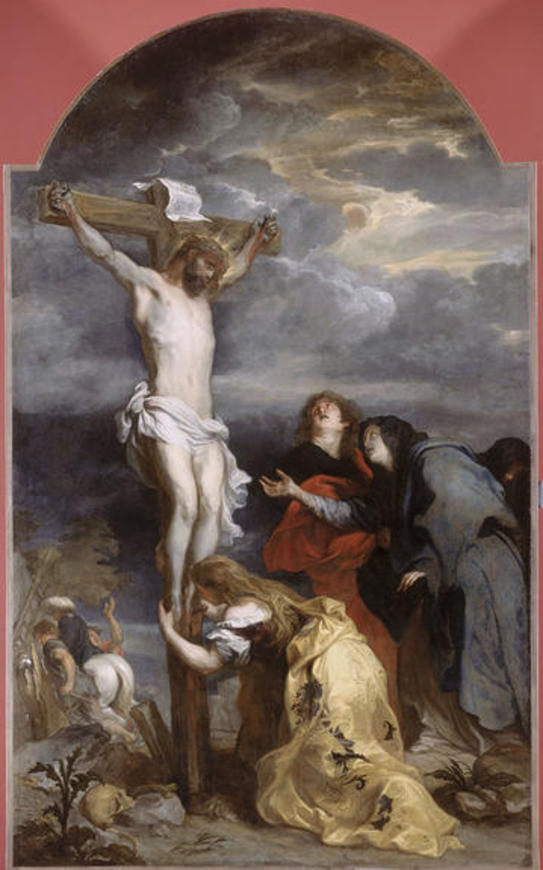This monumental altarpiece was created during the Catholic reform, which promoted the development of religious institutions like the Récollets. To glorify God and convince the faithful, churches were embellished with furniture and artworks.
The Christ on the Cross is also entitled "the Calvary" or "the Crucifixion". Jesus is represented here, nailed to a cross. His mother, the Virgin Mary, along with Saint John and Saint Mary Magdalene appear at his feet, accompanying him during his agony. A skull placed on the ground, traditionally identified as that of Adam, symbolises the journey between death and the Resurrection.
Why choose a Crucifixion for this placement within the church? This episode is often chosen for the high altar: the altar of the choir in which the Eucharist is celebrated, a sacrament which recalls Christ's sacrifice and his death. There may also be another reason: the convent is said to have possessed a thorn from Christ's crown and part of the Holy Cross. The presence of these relics may have induced a devotion to the Passion of the Christ. The choice of subject for this altarpiece was, therefore, clear!
The painting was very likely painted around 1630, after the artist's return from Italy. His finest altarpieces date from this period. There is a clear Venetian influence: observe the vibrant, golden light on the brocade and Mary Magdalene's hair! The composition is dynamic and original: oblique lines create movement, giving the scene a dramatic tension, heightened by the off-centred cross. In the sky, an ominous twilight takes over and adds its own touch to the drama! In associating nature with the event in this way, Van Dyck adopts an approach reminiscent of the Romantic spirit, creating a poignant work.
Detail 1: The Lille Palais des Beaux-Arts houses another painting by Van Dyck, taken from the Récollets convent. It was originally presented at the altar of the choir's right chapel, dedicated to Saint Anthony of Padua, and represents "The Miracle of the Mule".
Detail 2 : Originally, the Lille Palais des Beaux-Arts was located in the former Récollets convent. Van Dyck's Crucifixion can be seen in the foreground of Bonnier de Layen's painting, housed in the Lille Palais des Beaux-Arts.

This monumental altarpiece was created during the Catholic reform, which promoted the development of religious institutions like the Récollets. To glorify God and convince the faithful, churches were embellished with furniture and artworks.
The Christ on the Cross is also entitled "the Calvary" or "the Crucifixion". Jesus is represented here, nailed to a cross. His mother, the Virgin Mary, along with Saint John and Saint Mary Magdalene appear at his feet, accompanying him during his agony. A skull placed on the ground, traditionally identified as that of Adam, symbolises the journey between death and the Resurrection.
Why choose a Crucifixion for this placement within the church? This episode is often chosen for the high altar: the altar of the choir in which the Eucharist is celebrated, a sacrament which recalls Christ's sacrifice and his death. There may also be another reason: the convent is said to have possessed a thorn from Christ's crown and part of the Holy Cross. The presence of these relics may have induced a devotion to the Passion of the Christ. The choice of subject for this altarpiece was, therefore, clear!
The painting was very likely painted around 1630, after the artist's return from Italy. His finest altarpieces date from this period. There is a clear Venetian influence: observe the vibrant, golden light on the brocade and Mary Magdalene's hair! The composition is dynamic and original: oblique lines create movement, giving the scene a dramatic tension, heightened by the off-centred cross. In the sky, an ominous twilight takes over and adds its own touch to the drama! In associating nature with the event in this way, Van Dyck adopts an approach reminiscent of the Romantic spirit, creating a poignant work.
Detail 1: The Lille Palais des Beaux-Arts houses another painting by Van Dyck, taken from the Récollets convent. It was originally presented at the altar of the choir's right chapel, dedicated to Saint Anthony of Padua, and represents "The Miracle of the Mule".
Detail 2 : Originally, the Lille Palais des Beaux-Arts was located in the former Récollets convent. Van Dyck's Crucifixion can be seen in the foreground of Bonnier de Layen's painting, housed in the Lille Palais des Beaux-Arts.